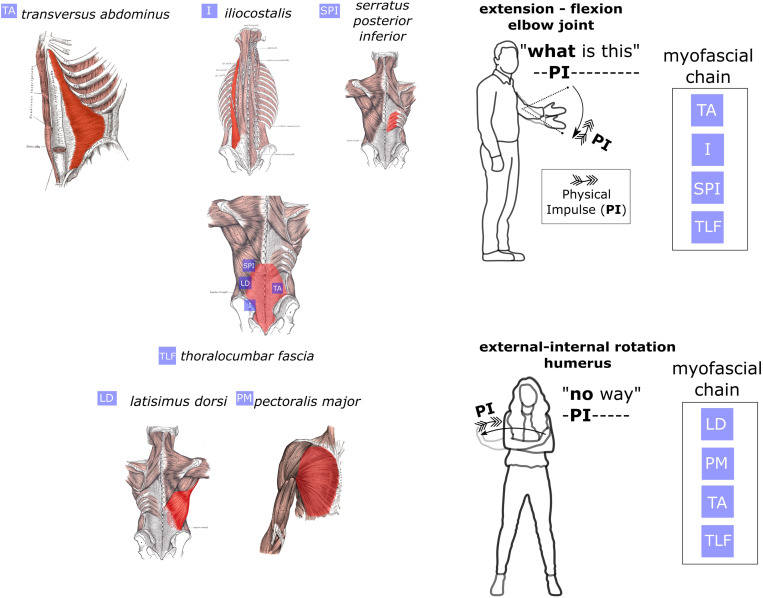The commentary by Ravignani and Kotz (1) affords us an opportunity to clarify the interpretation of our recent findings (2). We showed that “although listeners could only hear and not see the vocalizer, they were able to completely synchronize their own rhythmic wrist or arm movement with the movement of the vocalizer which they perceived in the voice acoustics” (ref. 2, p. 11364). We interpreted these results as “corroborat[ing] recent evidence suggesting that the human voice is constrained by bodily tensioning affecting the respiratory–vocal system” (ref. 2, p. 11364). Thus, we were surprised to read that Ravignani and Kotz believed that we “attribute[d] this rhythmicity [of the speaker’s voice] to voice modulation” (1). This is a misunderstanding of our position. In ref. 2 and elsewhere (3–5) we have argued that gesture affects speech through the forces it produces on the respiratory–vocal system.
Physical impulses produced by upper-limb movements can reach the respiratory–vocal system by a number of routes, for example via direct respiratory-related muscle tensioning around the chest to internally rotate the humerus (Fig. 1, Lower). Furthermore, impulses away from the center of pressure (Fig. 1, Upper) will recruit a chain of anticipatory postural muscle tensions around the trunk that are also implicated in respiration (6). We have indeed shown that postural instability modulates the effects of upper-limb movements on vocalization (3).
Fig. 1.
Muscle tensioning involved in moving the upper limbs during speech. Human pose images credit: Dimensions.com. Anatomical images credit: Wikimedia Commons/Mikael Häggström.
Breathing entrains with movements of various kinds, including arm movements (7), but our results are not explainable through “breathing” rhythms per se. Our participants vocalized continuously within each trial; therefore, only the exhalation portion of the breathing cycle was considered. We propose that upper-limb physical impulses on the trunk affect subglottal pressure, increasing expiratory flow and thus impacting cooccurrent vocalization (4). If, as suggested by Ravignani and Kotz (1), participants were asked to merely exhale (not vocalize) while rhythmically moving their arms, we would predict that the sound produced by the exhalation would also carry information about those movements, just as vocalizations did. Whether one is using the respiratory–vocal system for steady vocalization or exhalation, the forces produced by arm movements should affect those functions.
We focused on the effects of gesture on vocalization, rather than breathing or other rhythmic physiological functions, because vocalizations cooccur with gestures in humans, and both are intended to convey information to a listener. The implications of our results are that vocalizations carry information about how a speaker is moving via the effects of bodily tensioning on the acoustic signal. Gestures are, in effect, heard as well as seen.
The commentators attribute a common view (8) to us that humans “were gestural apes before ... vocal apes” (1). We, however, suggest that upper-limb movements impacted the respiratory–vocal system by biomechanical necessity at whatever moment in phylogenetic history the environment started to solicit their simultaneous activity. This is impartial to whether gesture or vocalization emerged first in our species.
Acknowledgments
This research has been funded by The Netherlands Organisation of Scientific Research (NWO; Rubicon Grant “Acting on Enacted Kinematics,” Grant no. 446-16-012; PI W.P.). In writing the research report, W.P. has further been supported by a DCC fellowship awarded by the Donders Institute for Brain, Cognition and Behaviour, and a postdoctoral position within the Language in Interaction Consortium (Gravitation Grant 024.001.006 funded by the NWO).
Footnotes
The authors declare no competing interest.
References
- 1.Ravignani A., Kotz S. A., Breathing, voice, and synchronized movement. Proc. Natl. Acad. Sci. U.S.A. 117, 23223–23224 (2020). [DOI] [PMC free article] [PubMed] [Google Scholar]
- 2.Pouw W., Paxton A., Harrison S. J., Dixon J. A., Acoustic information about upper limb movement in voicing. Proc. Natl. Acad. Sci. U.S.A. 117, 11364–11367 (2020). [DOI] [PMC free article] [PubMed] [Google Scholar]
- 3.Pouw W., Harrison S. J., Dixon J. A., Gesture-speech physics: The biomechanical basis for the emergence of gesture-speech synchrony. J. Exp. Psychol. Gen. 149, 391–404 (2020). [DOI] [PubMed] [Google Scholar]
- 4.Pouw W., Harrison S. J., Esteve-Gibert N., Dixon J. A., Energy flows in gesture-speech physics: The respiratory-vocal system and its coupling with hand gestures. Journal of the Acoustical Society of America, in press. [DOI] [PubMed]
- 5.Pouw W., et al. Gesture-speech physics in fluent speech and rhythmic upper limb movements. PsyArXiv:10.31234/osf.io/359te (11 June 2020). [DOI] [PMC free article] [PubMed]
- 6.Cordo P. J., Nashner L. M., Properties of postural adjustments associated with rapid arm movements. J. Neurophysiol. 47, 287–302 (1982). [DOI] [PubMed] [Google Scholar]
- 7.Ebert D., Rassler B., Hefter H., Coordination between breathing and forearm movements during sinusoidal tracking. Eur. J. Appl. Physiol. 81, 288–296 (2000). [DOI] [PubMed] [Google Scholar]
- 8.Tomasello M., The Origins of Human Communication (MIT Press, 2008). [Google Scholar]



